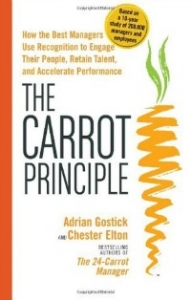How do you create a team where almost is replaced by above and beyond?
Knowing what makes your people tick is a wise place to start.
It’s said that the biggest motivator for employees is being recognised for their contributions.
When people are motivated they’re fired up – inspired to do a great job, supporting their colleagues to smash their goals and propel the business forward.
The Carrot Principle is a book about how managers use recognition to motivate and engage employees, boost retention, enhance customer satisfaction and accelerate performance.

‘With breakthrough research of 200,000 people over 10 years, and massive new global data collected by Towers Perrin, The Carrot Principle demonstrates how constructive praise and meaningful rewards powerfully motivate employees to excel, engage, and bring their best to work every day.’
‘Using the Carrot Principle, it is possible to create a team where almost can be replaced by above and beyond.’
Carrot research reveals that 79% of people who leave their jobs cite a lack of appreciation as their reason for jumping ship. Yet a staggering 74% of leaders worldwide still don’t practice recognition.
Internal comms teams who play a role in influencing management are perfectly placed to promote recognition programmes, sending incredibly powerful signals to employees and directly targeting specific business goals.
Whether you’re starting from scratch or refreshing existing strategies, stay focused on a few core goals, keep it simple and keep it genuine. Look up The Carrot Principle for 125 inspiring ideas split into 5 different categories – goal setting, communication, recognition, trust and accountability – and keep an eye on our blog for future posts where we’ll explore more of our own thoughts. In the meantime, here are 10 ideas we’ve come across that are being used to make employee recognition an everyday practice:
- Use feedback as positive reinforcement– When did you last review the way feedback is given to employees? Are managers still rolling out the old “praise sandwich” approach? Use feedback as a positive way to reinforce the right behaviours in your business in a transparent and meaningful way.
- Communicate the purpose– Take the time to explain to employees (especially new entrants) why they’re doing what they do. Explain what drives the organisation they’re a part of and how their individual efforts make the difference. Share the organisation’s purpose so they can believe in the Why.
- The Board of Thanks– Create a highly visual communal place to display memos, notes and photos, recognising progress and thanking individual employees for their efforts. Public recognition carries serious clout.
- Reading material– Thank an employee who has gone above and beyond with a magazine subscription – this could be work related or simply a subject you know they’re interested in.
- Presents for problem solvers– Thank employees who’ve solved particular problems by giving them a puzzle as a present – choose a theme you know they’re interested in.
- For your extroverts– Employees who are outgoing respond well to public recognition. Make an announcement to the department, or invite them on stage at the next company meeting. Getting recognition from coworkers can be highly gratifying and inspiring for others too.
- For your introverts– Recognise these employees in a more private way. Handwrite a thank-you note, or chat with them individually about their achievement. If they like the idea of public recognition without the worry of stage fright, suggest they write about their achievements in your internal newsletter.
- Employee Appreciation Day– Once a year, hold a ‘Thank You Day’ where managers show their gratitude and recognise the efforts of their teams by supplying, cooking and serving food and drinks.
- An audience with the CEO– Arrange for a team to personally present the results of their efforts to senior leaders or the CEO. Demonstrating appreciation by leaders taking the time to listen is a powerful motivator.
- Name check significant achievements– Acknowledge individual achievements by using the names and photos of employee’s when preparing regular performance updates or status reports.
Many of these will be reminders of ideas you’ve tried out before. Others will prompt you to think about new ways to build an open culture of employee recognition to engage employees and achieve objectives. As previously mentioned, focus on core goals, keep it genuine and build a strategy around what works best for your own employees.
Final thoughts
When it comes to employee recognition, it’s crucial that managers sustain their efforts, following up with frequent positive validation. Therefore it makes sense to be realistic about the methods you choose. Settle on the best ideas for your organisation and commit to them. Remember the importance of context too. Employees who know that their efforts are making a difference are far more likely to work toward accomplishing defined goals.
It’s an ongoing process – measure results periodically – what has been the impact on productivity? Employee retention rates? Engagement scores? Continually assess recognition efforts to determine what is working and what can be improved. Ensure managers are trained and provided with the tools they need.
Focus on business objectives and reward behaviour that directly impacts your overarching goals – and shout about the results!
Use the power of employee recognition to leave almost behind and reach above and beyond.
We’d love to hear about your own experiences and recognition ideas. Tweet us @Alivewithideas to share!
















